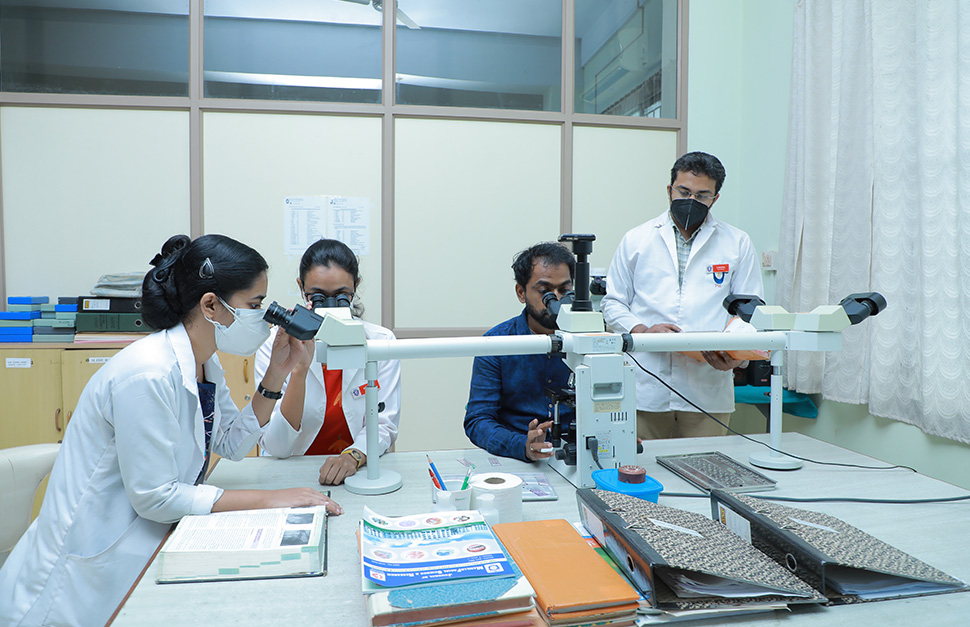
Oral and Maxillofacial Pathology deals with the nature of oral diseases, their causes, and effects. It relates the clinical manifestation of oral diseases and is concerned with the final microscopic diagnosis of diseases of the oral and maxillofacial region. Oral oncology, Forensic odontology and Advanced molecular techniques also come within the purview of this speciality.
The Department of Oral and Maxillofacial Pathology is involved in the training of undergraduates and postgraduates in the speciality. As part of the undergraduate dental training program Dental Anatomy, Embryology and Oral Histology is taught in the first year of BDS Course, while in the third year of BDS the students gain proficiency in diagnosing common oral and dental diseases through the curriculum of Oral Pathology and Microbiology.
The postgraduate training program will develop the highest level of microscopy diagnostic skills utilizing when appropriate, new technologies in immunohistochemistry and molecular studies. At the completion of Postgraduate program, it is expected that the student will have achieved high degree of proficiency in the subject matter and develop competence in research and its methodology. This will prepare the candidate for a career in teaching, research and specialty practice.
The Department of Oral and Maxillofacial Pathology provides external biopsy services, special staining techniques and IHC facilities for clinical and research purposes. The penta-head research microscope, fluorescent microscope, stereomicroscope, polarizer, and a cell culture laboratory are advanced facilities available in the department.
Common Oral Pathologies: Identification, Causes and Symptoms
Oral pathology and microbiology is a dental specialization and discipline of pathology that is concerned with the nature, identification, and management of diseases affecting the oral and maxillofacial regions at the macroscopic and microscopic levels. The patient’s personal health history plays an important role in identifying and treating the oral diseases. Common types of oral pathology include periodontal disease or gum disease, Oral Cancer (the most serious type of oral pathology), cold sores or Simplex Virus Type 1, canker sores, Malocclusion (misalignment), Candidiasis (Thrush), black hairy tongue, dental cavities, hand, foot and mouth disease.
Identification and Diagnosis for Oral Pathology & Microbiology
Patients are generally referred for oral pathology and microbiology examinations and treatments by general dentists. The mucosa in the mouth is generally smooth in texture and a coral pink in colour. Changes in the texture or colour of the mucosa could indicate the existence of an oral disease. Lesions such as ulcers or bumps in the oral cavity identified by the oral pathologist undergo a thorough review after considering the patient’s history of the lesion, medical history, medications and supplements, social history and allergies. The oral pathologist and surgeon will together decide whether the lesion requires monitoring, medical management or performing a biopsy for histopathological evaluation.
Diagnosis for oral pathologies are arrived at, after an oral examination, radiological examination and by using other diagnostic aids to examine the different parts of mouth including lymph nodes, saliva, natural teeth, artificial teeth and observation of oral hygiene.
Oral Pathology in Children: Unique Considerations
Small children as well as teenagers manifest a variety of oral lesions including hard and soft tissue lesions of the oral & maxillofacial region, particularly in the oral cavity of neonates. There are a few conditions specific to pediatric patients that must be considered before embarking on a treatment plan. Children have developing tooth follicles, so it is important to ensure that they do not get injured during surgery of the maxilla and mandible.
Microbiological Studies: Characterizing Oral Microbiota and Its Role in Health and Disease
The oral cavity contains a wide range of microbial species (over 700 bacterial species as well as fungi, viruses, archaea, and protozoa) that usually coexist harmoniously with each other as well as their host. Factors like poor diet, lack of proper oral hygiene, tobacco smoking and certain medications disturb this harmony, with potential implications on both oral and systemic health. This imbalance results in dental issues like dental caries, periodontal diseases, oral candidiasis and other pathological conditions.

